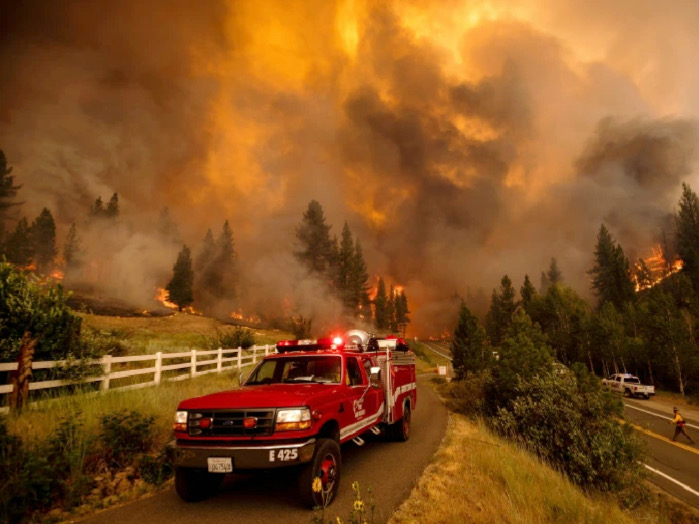8 Natural Disasters That Will Make You Take Climate Change (More) Seriously

SHARE
If you’ve been on the news recently, you might have heard greatly devastating natural disasters happening across the globe due to climate change. Scientists trace these extreme weather conditions to climate change, which, frankly, comes as no surprise.

By this time, we’re no strangers to natural catastrophes, but that does not make them appear any less frightening. Perhaps what turns out to be more alarming is that everything seemed to occur around the same time, one after another. There were severe floods, wildfires, and unprecedented weather changes affecting separate areas of the globe just in the past weeks.
Natural Disasters Sweep the World
How is the world doing? Let’s ready our hearts and take a look at the extreme weather and climate disasters occurring worldwide.
- Floods in Western Europe
Catastrophic flooding affected large areas of western Europe due to unprecedented rainfall beginning last July 13. Germany, the Netherlands, and Belgium are the hardest-hit countries severely affected by the rapid water level rise.
The Maas River, flowing northward through Belgium and the Netherlands, was said to have risen to its highest level in a century. Germany’s president described the destruction as their “worst natural disaster.”
The death toll has risen to more than 180, with hundreds still missing.
- Wildfires in the Western US and Canada

80 huge wildfires are devastating the U.S. west coast from California, New Mexico, Alaska, and Minnesota because of drought. That is about 1,800 square miles of land across 13 states.
The weather has not been helping. Firstly, federal officials said that the Tamarack fire was ignited by a lightning strike (it’s said to be a “dry lightning” season — a lot of lightning with little rainfall) on July 4. Now, strong winds have contributed to the expansion of the dozens of wildfires in Oregon.
The wildfires have prompted surrounding communities to evacuate. And the devastating effects even reach the east coast: New York has been experiencing the worst air quality in 15 years, with smoke carried thousands of miles from the west.
In Canada, around 226 uncontrolled active fires have torched homes in different provinces as of July 14. Although typical for the country, this year’s summer months have been extra intense and destructive.
Experts attribute the fires to climate change, extreme heat, and prolonged drought. It’s even creating its own weather systems — the perfect firestorm conditions.
- Sandstorm in Utah
Utah’s recent sandstorm caused a series of car crashes resulting in 8 deaths. A strong thunderstorm was reported in the area at the time: strong winds occurred with little precipitation, which didn’t help the gusty winds kicking up dust.
The region is one of the most affected areas by the historic drought conditions now being experienced in the West. More than wildfires, it makes dust storms more likely to occur.
- Hailstorm in Italy
A violent hailstorm halted traffic at a highway in Northern Italy, between Milan and Naples, as hail smashed cars’ windows. Hail the size of tennis balls damaged hundreds of cars forcing drivers to pull up. Apple orchards in Italy’s Val di Non region are also affected by the phenomenon.
Although hailstorms are common in the area, this year’s extreme weather has been described as “unusual.” From the frequency to the size of the hailstones, it has been more intense.
- Floods in China
Record-breaking rainfall poured in Zhengzhou City in Henan province, home to 12 million residents, between July 17 and 20. It was said that a year’s worth of rainfall has fallen in three straight days.
The rare and severe rainfall have caused extreme flooding not just in the provincial capital of Zhengzhou. Another city hit the hardest was Xinxiang City, along with 58 counties. Neighborhoods were submerged; the mile-long road tunnel of Jingguang had strong currents rushing about. Dams and reservoirs overflowed, reaching warning levels while cars were stuck, swept away, and floated in floodwaters.
One of the most heartbreaking scenes in this disaster was at the Zhengzhou subway, where 500 people were trapped. Some passengers had started bidding goodbyes to their loved ones through videos while in chest-deep waters. The death toll has now reached 71, according to the latest reports.
- Floods and Wildfires in Russia
At least eight people were killed by torrential rain in Southern Russia resort cities. Three rivers overflowed, and the stormy seas have damaged Sochi beaches. Just in: the Sochi region is now hit by floods for the second time this month.
And that’s not all. A Siberian forest is engulfed by smoke due to the sprawling wildfires as of Monday, July 26. The area is so large, about 1.88 million hectares (larger than the state of Connecticut), that majority of the fires are not being controlled.
- Monsoon Rains and Earthquake in the Philippines
The Philippines and its continuous monsoon rains, floods, and recent earthquake makes it to the list.
Last July 24, a magnitude 6.6 earthquake hit Batangas. It was felt in Metro Manila, parts of Luzon, and up to some areas in the Visayas. Thankfully, somehow, no extreme damages were expected after the tremor.
But in the past several days, heavy monsoon rains were also causing waist-deep floods in various parts of the capital. It was reported that more than 14,000 people were evacuated. More monsoon rains, along with another tropical storm, are still expected in the coming days.
- More flooding in Asia
As if the severe flooding in China and the Philippines isn’t enough, deadly flash floods are experienced in several countries in Asia, namely Bangladesh, Myanmar, Yemen, and India.
Heavy rainfall caused extreme flooding and landslides affecting agriculture, aquaculture, and infrastructure while prompting back-to-back rescue operations. Hundreds of people were displaced as fatalities rise in each nation.
Extreme Weather: A Consequence of Climate Change
These weather events so severe all happened in just the last few weeks. It has been downright startling and happening so fast. A climate crisis is pinned to be a common denominator across all these natural disaster headlines happening worldwide.

According to climate scientists, the extreme temperatures and unprecedented rainfalls that the world has been seeing today have long been predicted. Michael Mann of Pennsylvania State University says it’s not proceeding faster. In fact, “the warming is right in line with model predictions decades ago. Rather, it’s the fact that some of the impacts are greater than scientists predicted.”

As another climate scientist Corinne Le Quere puts it, “Global warming was well projected, but now you see it with your own eyes.”
*Cover Photo/Thumbnail Photo from aljazeera.com
RELATED ARTICLES

I’m a Christian and I Got No Startup Money!

Tempted to Abandon My Calling

A Christian’s Call to Wise Listening









